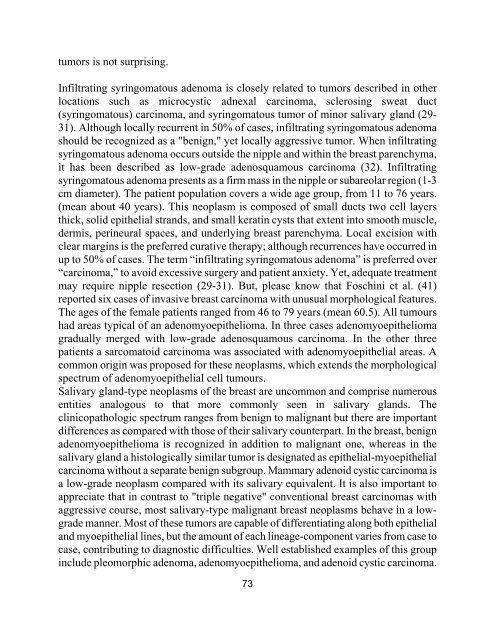33 Special Types of Invasive Breast Carcinoma: Diagnostic Criteria ...
33 Special Types of Invasive Breast Carcinoma: Diagnostic Criteria ...
33 Special Types of Invasive Breast Carcinoma: Diagnostic Criteria ...
You also want an ePaper? Increase the reach of your titles
YUMPU automatically turns print PDFs into web optimized ePapers that Google loves.
tumors is not surprising.<br />
Infiltrating syringomatous adenoma is closely related to tumors described in other<br />
locations such as microcystic adnexal carcinoma, sclerosing sweat duct<br />
(syringomatous) carcinoma, and syringomatous tumor <strong>of</strong> minor salivary gland (29-<br />
31). Although locally recurrent in 50% <strong>of</strong> cases, infiltrating syringomatous adenoma<br />
should be recognized as a "benign," yet locally aggressive tumor. When infiltrating<br />
syringomatous adenoma occurs outside the nipple and within the breast parenchyma,<br />
it has been described as low-grade adenosquamous carcinoma (32). Infiltrating<br />
syringomatous adenoma presents as a firm mass in the nipple or subareolar region (1-3<br />
cm diameter). The patient population covers a wide age group, from 11 to 76 years.<br />
(mean about 40 years). This neoplasm is composed <strong>of</strong> small ducts two cell layers<br />
thick, solid epithelial strands, and small keratin cysts that extent into smooth muscle,<br />
dermis, perineural spaces, and underlying breast parenchyma. Local excision with<br />
clear margins is the preferred curative therapy; although recurrences have occurred in<br />
up to 50% <strong>of</strong> cases. The term “infiltrating syringomatous adenoma” is preferred over<br />
“carcinoma,” to avoid excessive surgery and patient anxiety. Yet, adequate treatment<br />
may require nipple resection (29-31). But, please know that Foschini et al. (41)<br />
reported six cases <strong>of</strong> invasive breast carcinoma with unusual morphological features.<br />
The ages <strong>of</strong> the female patients ranged from 46 to 79 years (mean 60.5). All tumours<br />
had areas typical <strong>of</strong> an adenomyoepithelioma. In three cases adenomyoepithelioma<br />
gradually merged with low-grade adenosquamous carcinoma. In the other three<br />
patients a sarcomatoid carcinoma was associated with adenomyoepithelial areas. A<br />
common origin was proposed for these neoplasms, which extends the morphological<br />
spectrum <strong>of</strong> adenomyoepithelial cell tumours.<br />
Salivary gland-type neoplasms <strong>of</strong> the breast are uncommon and comprise numerous<br />
entities analogous to that more commonly seen in salivary glands. The<br />
clinicopathologic spectrum ranges from benign to malignant but there are important<br />
differences as compared with those <strong>of</strong> their salivary counterpart. In the breast, benign<br />
adenomyoepithelioma is recognized in addition to malignant one, whereas in the<br />
salivary gland a histologically similar tumor is designated as epithelial-myoepithelial<br />
carcinoma without a separate benign subgroup. Mammary adenoid cystic carcinoma is<br />
a low-grade neoplasm compared with its salivary equivalent. It is also important to<br />
appreciate that in contrast to "triple negative" conventional breast carcinomas with<br />
aggressive course, most salivary-type malignant breast neoplasms behave in a lowgrade<br />
manner. Most <strong>of</strong> these tumors are capable <strong>of</strong> differentiating along both epithelial<br />
and myoepithelial lines, but the amount <strong>of</strong> each lineage-component varies from case to<br />
case, contributing to diagnostic difficulties. Well established examples <strong>of</strong> this group<br />
include pleomorphic adenoma, adenomyoepithelioma, and adenoid cystic carcinoma.<br />
73


